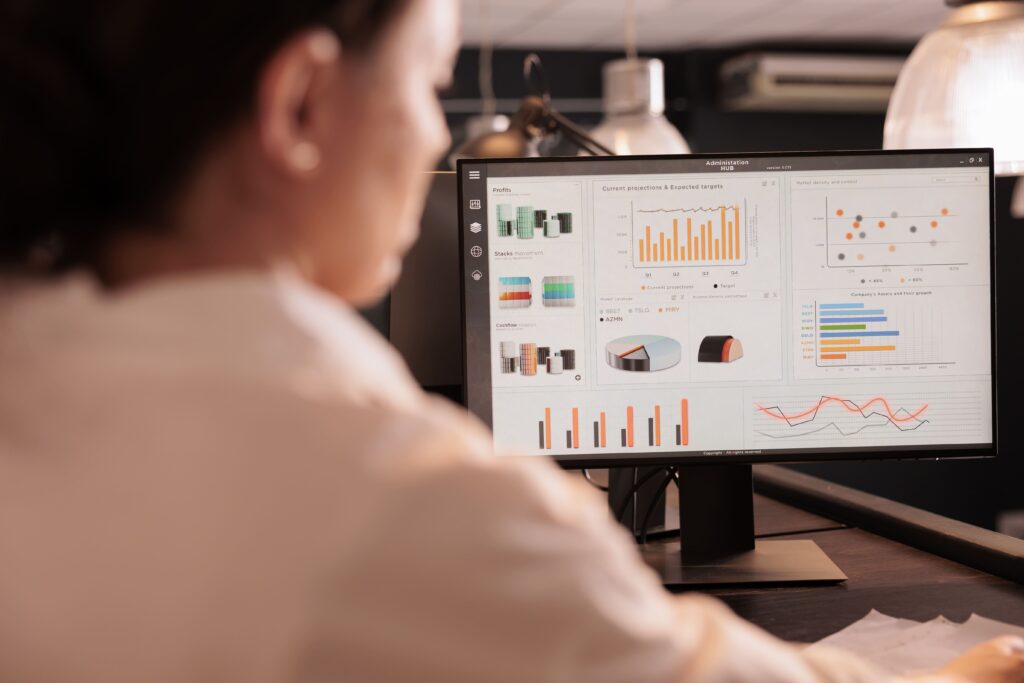Data visualisation has become an indispensable tool in the modern business landscape, transforming complex data sets into clear, actionable insights. For professionals aiming to excel in strategic marketing or data-driven roles, mastering data visualisation is not just advantageous—it’s essential.
This article explores key techniques, types of charts, and tools used in data visualisation to enhance clarity and decision-making.
Pursuing an advanced degree, such as the Online Master of Science in Strategic Marketing at EDHEC can equip you with the necessary skills to leverage data visualisation effectively in your strategies.

What Is Meant by Data Visualisation?
Data visualisation refers to the graphical representation of information and data. By employing visual elements like charts, graphs, and maps, it provides an accessible way to identify and understand trends, outliers, and patterns within data sets. This process simplifies complex information, making it easier for stakeholders to comprehend and act upon.
Why Is Data Visualisation Important?
In today’s data-driven world, the ability to interpret and present data effectively is crucial. Data visualisation aids in:
- Identifying Trends and Patterns: Visual representations make it easier to spot emerging trends and recurring patterns, facilitating informed decision-making.
- Enhancing Communication: Complex data can be communicated more clearly through visuals, ensuring that all stakeholders, regardless of their technical expertise, can grasp the insights.
- Driving Strategic Decisions: By presenting data visually, organisations can make strategic decisions based on clear and concise information.
Types of Charts for Effective Visualisation
Different types of charts serve different purposes in data storytelling:
- Bar Chart: Compares quantities across categories. Ideal for side-by-side comparison.
- Line Chart: Shows change over time or trends. Great for time series data.
- Pie Chart: Displays proportions. Best used with few categories.
- Area Chart: Highlights cumulative totals. Useful for showing volume.
- Boxplot: Visualises the spread and skewness of data. Effective in statistical analysis.
Visualising: Bringing Data to Life
Visualising data is about turning raw numbers into visual narratives:
- Use consistent colours and scales to avoid confusion
- Maintain a clean, uncluttered design
- Incorporate labels and legends to guide viewers
- Animate or layer information in interactive dashboards to increase depth
Visualisation makes insights more engaging and decisions more data-informed.

What Are the Three Types of Data Visualisation?
Data visualisation can be broadly categorised into three types:
Charts and Graphs:
These include bar charts, line graphs, and pie charts, commonly used to represent quantitative data and show relationships between data points.
Maps and Geospatial Visualisations:
Utilised to display data related to geographical locations, helping in identifying regional patterns and trends.
Diagrams and Matrices:
These visualisations, such as flowcharts and heat maps, are used to represent processes, relationships, or to show the intensity of data variables.
Different Types of Charts in Data Visualisation
There is no one-size-fits-all chart. Here are some additional types used by data analysts and designers:
- Histogram: Distributes data into intervals to show frequency
- Bubble Chart: A scatter plot where data points have different sizes to represent another variable
- Treemap: Shows parts of a whole through nested rectangles
- Radar Chart: Compares multiple variables on a two-dimensional plane
Choosing the right chart helps communicate insights more effectively.
What are the Five Data Visualisation Techniques?
To effectively present data, various visualisation techniques are employed:
- Bar Charts: Ideal for comparing quantities across different categories.
- Line Charts: Best suited for displaying trends over time.
- Pie Charts: Useful for illustrating proportions within a whole.
- Scatter Plots: Employed to show relationships between two variables.
- Heat Maps: Used to represent data values as colours, indicating intensity or frequency.
What are the 5 C’s of Data Visualisation?
The 5 C’s are guiding principles that ensure clarity and effectiveness in visual communication:
- Clear: Visuals should be easy to understand at a glance
- Concise: Avoid unnecessary clutter—only include essential data
- Contextual: Provide background information or benchmarks to support the visual
- Compelling: Engage the viewer with appealing design and storytelling
- Credible: Ensure the data is accurate and sourced reliably
What Is a Visualisation Diagram?
A visualisation diagram is a rough sketch or drawing that represents the intended design of a static image product. It includes annotations to describe design ideas and is typically used during the planning stages of a project to convey concepts and layouts. In data visualisation, it can help define the structure and key messages of complex visual reports.
How to Visualise Data Effectively?
Effective data visualisation goes beyond choosing the right chart type. It involves:
- Data Cleaning and Preparation: Ensure data accuracy and remove inconsistencies.
- Choosing the Right Format: Select the most appropriate visualisation based on your objective.
- Consistency in Design: Use consistent colours, fonts, and scales to aid interpretation
- Annotation and Labels: Guide the audience with clear legends, labels, and explanations.
- Interactivity (if digital): Add filters or hover effects to make data exploration easier.
How to Choose the Right Data Visualisation?
Selecting the appropriate data visualisation depends on the nature of the data and the message you intend to convey:
- Understand Your Data: Determine the type of data you have—categorical, numerical, or a mix—and the relationships you want to highlight.
- Define Your Objective: Clarify what you want to communicate: comparisons, trends, distributions, or relationships.
- Know Your Audience: Consider the audience’s expertise and what visualisation will be most effective for their understanding.
By aligning these factors, you can choose a visualisation that effectively communicates your data’s story.

Data Visualisation Tools and Software
Several tools are available to assist in creating effective data visualisations:
- Tableau: A powerful tool for creating interactive and shareable dashboards.
- Google Charts: Offers a variety of chart types and is compatible with web applications.
- Microsoft Power BI: Provides robust analytics and visualisation capabilities integrated with other Microsoft products.
- D3.js: A JavaScript library for producing dynamic, interactive data visualisations on the web.
- Python (Matplotlib, Seaborn): Widely used in data science for creating high-quality graphs.
Data Visualisation Examples Across Industries
Data visualisation is used in multiple fields to simplify data-driven decision-making:
- Marketing: Heatmaps to analyse user behaviour on websites
- Finance: Line graphs to track stock trends or investment returns
- Healthcare: Dashboards to monitor patient outcomes
- Education: Bar charts to display student performance metrics
- Business Intelligence: Dashboards integrating KPIs and visual data to support strategic decisions
Beyond Basics: Advanced Visualisation Concepts
- Boxplots: Display data distribution and variability using quartiles
- Area Charts: Show cumulative trends over time
- Network Diagrams: Illustrate relationships and flows between nodes
- Radial Charts: Present multivariate data in a circular layout
These advanced methods enable deeper exploration of complex datasets and are particularly useful in predictive analytics and AI-integrated platforms.
Designing with Purpose: Visualisation Best Practices
- Use visual hierarchy to emphasise key data
- Apply effective colour theory to differentiate data categories
- Minimise chartjunk—unnecessary or distracting visuals
- Choose the right chart for your goal: comparison, composition, distribution, or relationship
From Data to Strategy: The EDHEC Advantage
Incorporating data visualisation skills into your professional toolkit can significantly enhance your strategic marketing capabilities. The Online Master of Science in Strategic Marketing at EDHEC Business School offers comprehensive training in data analysis and visualisation, equipping you with the tools to transform data into actionable marketing strategies. For those looking to expand their expertise in data systems and advanced analytics, the Online Master of Science in Data Management and Business Analytics provides rigorous preparation in data governance, business intelligence, and visualisation.
Both programs prepare you to meet the demands of the modern marketing and data landscape, where data-driven decision-making is paramount.



